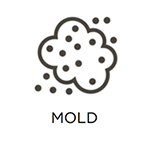RestorationMaster
Buildings constructed before 1980 often contain asbestos and lead, which are often found during fire or water damage restoration on the property. Abatement services are recommended to prevent health problems like cancer or organ damage.
Our technicians will assess the lead and asbestos present in the building. We will form a well-timed and affordable plan for asbestos and lead removal. We can handle a project of any complication or size, even if your requirements include insulation, abatement, or scaffolding. RestorationMaster offers asbestos and lead removal services to homes and buildings in Pearland, TX.
Problems Caused by Asbestos
Asbestos is not always bad, but it becomes dangerous to breathe when it crumbles and releases asbestos fibers into the air. Building materials like cabinet tops, shingles, ceiling tiles, and floor tiles contain asbestos but won’t release fibers unless they are disturbed or damaged. Aging, water damage, and physical impact can increase the risk of friable asbestos by damaging these materials.
The body is unable to remove asbestos fibers once they have entered the body because the fibers lodge into lung or body tissues. The fibers will remain there indefinitely and may cause diseases in the body, such as mesothelioma, asbestosis, and lung cancer.
Your likelihood of developing an asbestos-related disease depends on the following factors:
- Amount of exposure: You are more likely to develop health issues the more time you spend around asbestos. There is no safe amount of exposure, but those who are exposed more frequently are more at risk.
- Age: Children and the elderly are more likely to develop a disease caused by asbestos because their immune systems are weaker than adults.
- Smoking habits: Cigarette smokers who are exposed to asbestos are much more likely to develop an asbestos-related disease than someone who doesn’t smoke cigarettes. If you work with or are commonly exposed to asbestos, you should immediately quit smoking.
Be sure to minimize your exposure to asbestos because any amount increases your risk of developing lung cancer, mesothelioma, asbestosis, or another asbestos-related disease.
Problems Caused by Lead
It is dangerous to breathe lead particles because the body absorbs high levels of lead and creates health problems. Bones, tissue, and blood absorb lead and if a large amount is stored inside our bodies, we can experience lead poisoning. The following symptoms are a common indicator of lead poisoning:
- Fatigue
- Irritability
- Constipation
- Loss of appetite
- Memory loss
- Abdominal pain
- Headaches
These symptoms are commonly attributed to something else, so lead poisoning can easily be overlooked. Frequent exposure to lead can cause heart disease, high blood pressure, anemia, infertility, kidney and brain damage, and even death.
Pregnant women can introduce dangers to their unborn babies and may have a miscarriage or stillbirth if they are exposed to lead for any amount of time. Children show lead poisoning symptoms at much lower levels than adults, so they are usually much more affected.
Lead is likely responsible for cancer, according to the Department of Health and Human Services (DHHS), the Environmental Protection Agency (EPA), and the International Agency for Research on Cancer (IARC).
Abatement Process
According to the Environmental Protection Agency (EPA) and the Occupational Safety and Health Administration (OSHA), any amount of exposure to asbestos is dangerous, so the asbestos removal process should only be performed by a professional.
All areas and materials that contain asbestos should be considered dangerous and avoided. An inspector will perform an assessment of the property for potential hazards and take samples of questionable materials for analysis. If asbestos is found, our professionals will perform a complete removal or an encapsulation, otherwise known as abatement.
The materials and objects affected by asbestos will either be restored, meaning encapsulated, or removed completely if the damage is serious enough. Encapsulation is typically less expensive than removal, but the asbestos is encapsulated under a coat of sealant and not removed from the area.
Similarly to asbestos, the lead removal process should be performed by a professional and not the homeowner. An inspector will assess the property to determine the amount of lead contamination and form a detailed report that includes all relevant information.
Our technicians will use this report to determine the best course of action to remove lead and lead-based paint from your property. The abatement process will begin and may include encapsulation, scraping, stripping, and replacing the lead.
The inspector will return to the building to perform a final assessment after the lead removal process is completed. We will determine if the property is clean enough to pass the final inspection and earn a letter of compliance. This letter means the building is considered “lead safe” and safe for occupancy.
Contact Us
Our trained professionals have the certification and experience to remove asbestos and lead with our industry-approved techniques. We will protect the indoor environment of your building and safely remove hazardous materials. Contact RestorationMaster at (281) 213-5553 for our lead and asbestos removal services.





